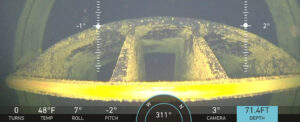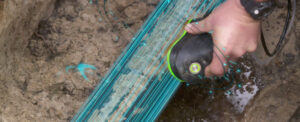
The Butterfly Valve Mystery
CPM’s recent project with a water utility client captured amazing footage providing a simple explanation for the (considered) inconsistent data captured through the client’s modeling software.
WATER: The Invaluable Natural Resource and How One North Texas City is Using New Technology to Protect its Constituents from Unforeseen Water Outages and Loss.
CPM Pipelines is honored to share the news about a North Texas municipality that took action and implemented a cutting edge in-line inspection technology to inspect a critical raw water supply line and support efforts to conserve a dwindling natural resource, water. So grab an ice cold glass of water, put your feet up, and enjoy the read.
New water in the earth’s atmosphere doesn’t exist. Let that sink in. Regardless of your beliefs, the unescapable truth is the same water the earth’s atmosphere began with is the water that’s slowly dwindling due to natural disasters, climate change, aged failing infrastructure, and water waste to name a few. The finite supply of water is becoming more evident as different entities and stakeholders vie to secure future water supply for their respective constituents. The dwindling of Lake Mead and Lake Powell and the ensuing battles among the seven states that are signatories to the 100-year old Colorado River Compact highlight the competitiveness to search for future water supplies, and how glib the future might be if water demands and infrastructure continue to be poorly managed.
The State of Texas is no different in this regard. In many ways, the climate in Texas forced this issue to be a priority long before it was the popular topic it is today. While unpredictable in terms of exact timing, droughts are a mainstay of Texas. According to the Texas Water Development Board’s Technical Note 21-01 entitled “Evaporative Losses from Major Reservoirs in Texas”, data collected for 114 reservoirs over the course of 18 years (2001 – 2018) shows the average net water loss to evaporation for each reservoir to be 1.91 million acre-feet (6.224 x 1011 gallons) per year. This factor alone solidifies the logic behind drought contingency planning for entities dependent on surface water and well water alike as wells are less likely to recharge when surface supplies diminish. Some entities have employed technologies that convert wastewater into potable water (toilet to tap) while other stakeholders are building large pipelines to reservoirs far away from their own service areas. Still, some municipalities and stakeholders are asking themselves, “what else can we do to ensure that our constituents have constant access to potable water?”.
One answer can be found in the existing infrastructure that supports the transmission and distribution of potable water to end users. Ultimately, it does no good to secure water rights if water is being lost in the transmission of raw water to the treatment plant and distribution from the treatment plant to the end user(s). This highlights another area in which Texas is much like the rest of the Country. Much of the infrastructure currently in place is at the end of its useful life, but there is nothing concrete to tell governing officials “You must replace this 30-inch cast iron pipe that was installed in 1954”. This leaves city staff’s and their consultants with a gut-wrenching prospect: “Do we proactively inspect a critical line based on it’s age or do we wait until it starts failing and hope that it isn’t a catastrophic failure?”. This is admittedly an over-simplification of the problem, but the over-arching question remains.
Recently, one North Texas municipality decided to answer this question by proactively inspecting a critical raw water supply line with the Acquarius in-line inspection technology from Acquaint based in the Netherlands. Based on ultrasound, Acquarius utilizes a smart pipeline inspection gauge (PIG) to collect data about the internal condition of the pipe. While sonic and ultrasonic technologies have been well documented to provide critical information such as wall-thinning, cracks, and delamination (PCCP, BWP), the technology was generally limited by time constraints due to long inspections, lack of automation, de-watering requirements, and lack of dimensional control (Failure Analysis, Condition Assessment Technologies, and Performance Prediction of Prestressed Concrete Cylinder Pipe: State-of-the-Art Literature Review; Shaoqin, Ge; Sunil, Sinha 2014 American Society of Civil Engineers). The Acquaint Acquairus has removed these limitations by developing a free-floating ultrasonic tool that is deployed while the pipeline is in service. Coupled with an on-board inertial mapping unit, odometer, sonde, and hydrophone the Acquarius provides information that no other technology on the market can provide: joint anomalies (joint gap width, axial deformation), delamination, remaining wall thickness of 1-2 layers of pipe (pipe type dependent), tangential deformation, leaching (AC), and corrosion. This technology is available for all pipe types (including plastics and asbestos cement) with diameter ranges from 6 inches to 48 inches.
The Results: A degree of relief was achieved with this inspection. Upon receiving the deliverable which included shape files with sub-meter location and clock position of each detected anomaly, CSV files with all data points collected during the inspection, a report highlighting the most relevant anomalies, and an on-line dashboard, the North Texas municipality that undertook the first inspection of its type in North America learned that, while the raw water line has some areas for further analysis, the overall condition of the pipe is good. There were no significant breaches to the inner core of the pipe and no serious structural concerns were detected. This information helps guide future decision making with regard to capital improvement dollars and master planning. In the end, this is the key to any inspection endeavor: collecting actionable date that can be utilized to inform future decision making.
Anything can happen and “anything” does happen. We see it every day and there is little we can do to mitigate what was impossible until it happened. We can, however, take proactive measures to protect our natural resources, critical assets and infrastructure. Water is life. One North Texas city is sleeping better tonight because of their proactive approach to protect a finite natural resource, and their constituents. How will you get inspired and take action?

CPM’s recent project with a water utility client captured amazing footage providing a simple explanation for the (considered) inconsistent data captured through the client’s modeling software.

CPM was contracted to perform a condition assessment inspection along two sections of 8-inch ductile iron pipe (DIP) waste activated sludge lines located in Arizona.

CPM was contracted to perform a phased pipe condition inspection utilizing INGU Pipers® free floating pre-screening inspection tools, Electromagnetic Bracelet Probe™ (BP) scanning, and ultrasonic thickness (UT) measurements on two wastewater force main pipelines.

Protecting human divers one Deep Trekker PIVOT inspection at a time. How a subaqueous swimming CCTV inspection solved the unknown in a 48-inch, potable water, intake pipeline 600-feet below.

An Arizona suburb pursues a long-term program to identify and locate leaks across its potable water pipeline system.

Blazing the trail of large diameter pressure pipe rehabilitation in the U.S.